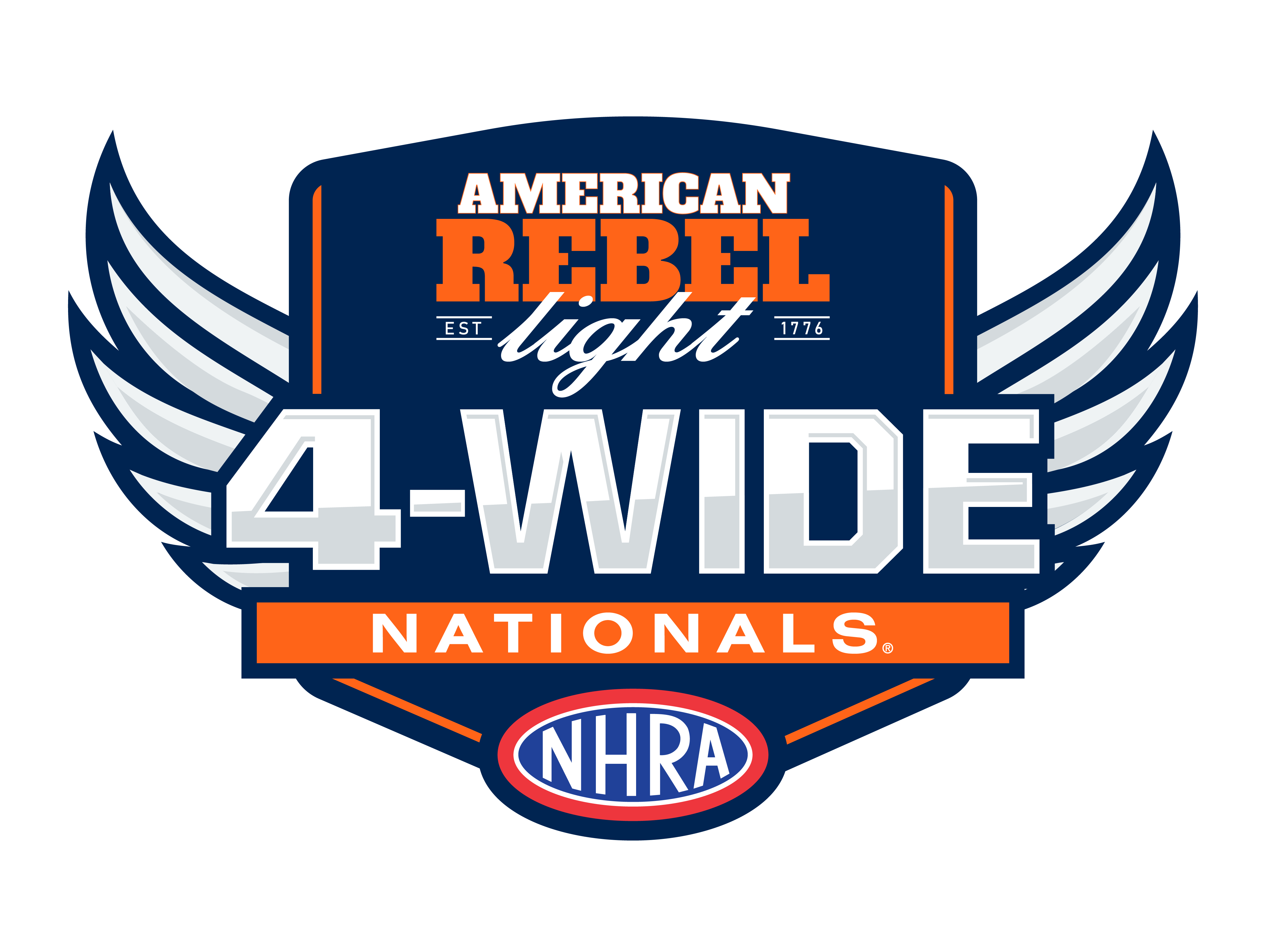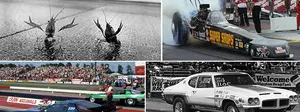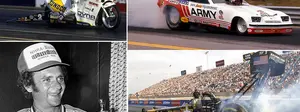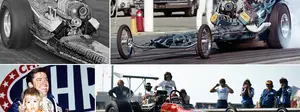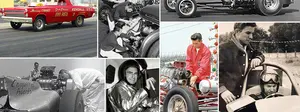

Everything you always wanted to know about 'Snake' (but were afraid to ask)

I’m not going to lie. I consider myself one of the foremost experts on the life and times of Don “the Snake” Prudhomme. It’s a depth of knowledge honed from years of fandom and work products — memorizing stats, cars, places, and things — and on what I like to think of as a close friendship with the man himself. So when he started telling me a few years ago about a new book he was working on about his life, I was obviously thrilled but also wary.
Prudhomme was already the subject of two previous books — Hal Higdon’s Six Seconds to Glory, covering his weekend at the 1973 U.S. Nationals and delving into the psychology of his racing, and Tom Madigan's in-depth look at Prudhomme and running mate Tom McEwen — not to mention a major motion picture on the duo, and there didn't seem to be a lot of unplowed ground to plant the seeds of success.
But, early on, the decision was made for this book, Don Prudhomme: My Life Beyond the 1320, to be about more than racing, e.t.s, and race wins, that he would open up about some deeply personal issues, which really intrigued me. He’d made a start on this project with Bill Stephens but it got shelved for a variety of reasons, but I remember him telling me even back then “Man, I’m really excited about this book, I’m going to talk about things I never thought I would."
Even a week ago, while waiting for my review copy to arrive, he was excited about the route he'd charted. “I really didn’t to do a book about just e.t.s and race wins; people already know that stuff,” he told me. “That's like watching the same movie over and over.”
Even with the talented, thorough, and passionate Elana Scherr as his co-author and their near-two years of development, when I opened the hefty tome — 192 pages between two hardcovers and weighing in at 2.1 pounds — I was definitely in “show me” mode because I knew that if he wasn’t going to solely concentrate on his racing successes, that opens up a whole lotta Don Prudhomme to talk about.
I remember thinking, “He’d better talk about his brother, Monette, who died during his glorious 1976 season. He’d better talk about how rough his childhood was. He’d better talk about how he wasn’t the easiest guy to get along with (“I admit it; I was an asshole back then,” he once told me privately, but would he say it publicly?) And he’d damned well better talk about his ethnicity.”
Check. Check. Check. Check.
Within the first half-dozen pages on the main body of the book, Prudhomme uncorks most of it: alcoholic parents and a dysfunctional family, his relationship with Monette, a learning disability, and begins to delve into the journey to discover his Black roots, which were hidden from him by his parents.

In these sensitive times, tackling issues of race can be a tricky proposition, and Prudhomme and Scherr handled it head-on but with sensitivity. Prudhomme's early admission that "It would have been nice to know I was Black when I was a kid" speaks volumes. He always knew from his features that it was likely he was of mixed race, especially given his family's Louisiana Creole background, but because there was no easy DNA testing like we have today and because his parents wouldn't tell him — to protect him in the racially-charged 1950s or out of ignorance or pride — he had a good idea, but even when asked by Black fans in the 1970s whether he was "a brother," he'd respond obliquely with "I'm everyone's brother."
Prudhomme puts a fair amount of weight into this subject. the kind of perspective that comes when you’re “nearly 80 years old” and your brain isn't otherwise occupied with crew chief drama, parts inventories, and sponsor woes. And, lest you think this is all about Prudhomme suddenly becoming “woke” because of the times, remember that this book and his agenda was underway for years. And, after all, no true discussion of self can begin without knowing what you are and where you came from.

“I just wanted to set the record straight; I’m not a kid anymore,” Prudhomme said when I grilled him about it after him grilling me about what I liked and didn’t like about the book. “It was just kind of time to clear the decks; hell, I’m 78 years old. Maybe I wasn’t ready earlier and I thought it wouldn’t have made a difference, but maybe it would make a difference to someone else. What you do at the racetrack has nothing to do with your skin color or anything else, so I’ve always tried to stay away from it, but it’s been on my mind for several years and I found a good partner in Elana to help me share the story.”
From my perspective, as a longtime NHRA employee, it closes some loops. The issue of “the Snake’s” race has been a hot topic since I joined the NHRA team in 1982, and for my fellow NHRA staffers before that. It was The Question That Shall Not Be Asked. Prudhomme didn’t want to even discuss it back then, so we never did. It came to a semi head when Antron Brown won the Top Fuel championship in 2012 and I was asked, “Is Antron the first Black racer to win a pro championship?” I was like, “Well, that depends …”
But the book is about so much more than that. Given the odds stacked against him by his parents’ alcoholism, his dyslexia, and his shyness, viewed through the long lens it’s a testament to the strength of human will and determination, of finding your purpose in life and letting that help you rise.
“Maybe there’s something in there that inspires some other kid who’s going through tough times and doesn’t realize he can make something out of himself if he applies himself,” he said. “Some kid who doesn’t know who they are or what they’re about.”
It’s also a great love story of his relationship with his wife, Lynn. Those of us close to “Snake” know the huge role she played in his career and now the general public will know. She’s the one who taught him to read because she knew that as good as he was behind the wheel and on wrenches, he needed those skills, too. (“I was always really good with numbers but I figured you didn't have to read anything but the spark plugs," he said to me, maybe only half-joking.)

The book is filled with all kinds of little eyebrow-raising nuggets. That daughter Donna was not named after him but for the Ritchie Valens song of the same name. That his longtime pal, Roland Leong, “the Hawaiian,” is actually three-quarters Chinese and only one-quarter Hawaiian (that admission comes directly from Leong, in one of the many sidebar interviews that Scherr conducted). That, a year before his famed "I wanna quit" moment after Jim Nicoll's crash at the 1970 U.S. Nationals, he felt the same sentiment after seeing John Mulligan’s terrible fire at the 1969 event. Who knew?
The most shocking moment comes with the revelation that “the Snake” almost died on a doctor’s exam table in 1976 during a heart catheterization test he took after freaking out following brother Monette's death from arterial disease before the age of 40, They (and we) actually did lose "Snake" for a second but brought him back with a defibrulator. Wild.
Even with all the personal-life revelations, this is still a book about drag racing. I know there are fans out there, even among the knowledgeable and passionate Insider Nation, who do only care about the cars and the numbers and the wins, and there’s plenty of that. Prudhomme talks at length about many of your favorite cars — the Greer-Black-Prudhomme dragster, the Hawaiian, the Shelby Super Snake, the Hot Wheels Wedge, the Yellow Feather, and black Snake III ‘Cuda — that you’re going to have everything you want.

The book is organized chronologically, which is not always common for autobiographies (believe me, I've read scores of them during long airplane flights to and from races) and it really works here. With each passing page and year, I found myself thinking ahead. "Is he going to talk about the black 'Cuda? What's he going to say about the Army Monza? Is he going to talk about his drag boat crash? What’s he going to say about his return to Top Fuel in the 1990s? What’s he going to say about Larry Dixon?”
Prudhomme talks at length about his amazing relationships with early partners like Keith Black, Roland Leong, Bob Brandt, and, of course, “the Mongoose,” Tom McEwen. We find out how Black felt about Prudhomme’s sudden switch of allegiance to Ed Pink power (always wondered about that one). I also never knew how much of an influence and mentor that Chris Karamesines was to him in those early days.
Prudhomme talks about his great successes (too many to mention) and even the mistakes (including the B&M Torkmaster and his return to Top Fuel in 1990). Prudhomme is quick to heap praise upon those who took the time to show him the ropes but equally quick to talk about the times and people he thought had wronged him. It's not done in a "take that" manner, but matter-of-factly, with his heart of his sleeve about the times people let him down or disappointed him.
At Scheer’s insistence, many of those people get a chance to tell their side of the story, and they do so candidly. Prudhomme accepted everything they said and didn’t ask to change a word.
The list of side-interview subjects is long and impressive. In addition to the aforementioned Leong and Brandt, Tommy Ivo, Kenny Bernstein, Pat Galvin, Ron Capps, Dixon, and Antron Brown all share their thoughts. (Brown's, which comes last, is very compelling as he helps grapple with the subject of race and what Prudhomme's acknowledgments mean.) We also hear from Prudhomme's sisters Joyce, Judy, and Jeanette, as well as Lynn and Donna, and even some kind words from other motorsports stars who entered his orbit, like Mario Andretti.

There are more than 250 photos or other pieces of art (posters, contracts, letters, etc.), some from the Prudhomme family’s collective photo albums and a ton right out of the National Dragster archives. “Snake” and Elana came to the NHRA HQ last June and we slapped probably 20 giant (but well-organized) file folders filled with black and white prints on the table then sat back and watched him go through them, commenting on people, parts, and moments that these photographic memories brought to him.
Elana shared a "funny" story with me about the photos that speak not only to the amount of work the book took, but how it was completed under trying conditions, yet they persevered.
“By the time we got to working on the captions, the [COVID] shutdown was already happening,” she said. “We couldn’t meet up, so we did them over FaceTime. I’d show him my computer [screen] over FaceTime and he’d tell me about the photos. I’d put my phone down and type the information into my computer and then move on to the next one. It was incredibly time-consuming, and we’d be doing it for about six hours and my computer crashed and it didn’t save my work. I was so pissed, and we had to do it all over the next day — about 100 captions — but he was such a good sport about it.
“I’d worked with him on a lot of things and we get along well and have fun together, but I’ve also worked on stories with him where he’s gotten pissed at me halfway through and he’d stop talking to me. Other people had told me how intense writing a book could be and that we’d fight, and we had some many challenges over the two years — my mother’s health and the coronavirus are just two of them — but throughout it all he was good to me and a good partner.”
You can see evidence of their great relationship in the promotional video embedded below
Her assessment of current-day Prudhomme brings me to the last of my checklists that I hoped Prudhomme would address. Because my time at National Dragster started in 1982, and 1983 and 1984 were not great years for “the Snake, I found out firsthand about his crankiness. Today, he’s so chill and friendly — he’ll call my cell just to see what’s going on and we’ll just BS for a half-hour, but back then, racing was everything and nothing could stand in the way.
“Man, for so long, drag racing was all I felt like I had going for me, and I wasn’t going to let anyone take it from me,” he explained when I reminded him about his “asshole” self-observation of a few years back. “If winning meant that I had to not be the most-liked guy in the pits, well, that was worth it to me. Looking back, yeah, I could have been a nicer guy, but at what cost?”

That's not to paint him with some kind of broad brush from an outsider, as he also goes into the topic at some depth throughout the book, acknowledging his fault and offering the perspective that the years have given him.
One of my favorite lines in the book comes from daughter Donna, who said, “He’s not a total dick,” and, according to Scherr, Donna’s favorite line from the book is her dad talking about the dramas that lie within teams, referencing especially the dying years of the Miller deal with Dixon: “I was an asshole, but I wasn’t the only one.”
It's candor like that that really brings this book to life.
OK, now it's time for me to be the a-hole. Almost any crew chief out there will tell you that even their best run could have been a little better if only he'd have done this or not done that to the tune-up, and the same goes for this book.
I think it's a brilliant and informative look at one of drag racing's great heroes, but it does have its warts ("Snake," you told me to be honest), but they all feel very minor.
My biggest beef is with the truncation of swear words. Anyone who knows Prudhomme knows that he litters his sentences with colorful language, but in the book, they’re reduced to f___ and s___ and so on. If there had been one or two, I could have overlooked it, but Prudhomme uses those words frequently and it gets a little wearing at times to see them repeatedly censored.
The choice to do that was a joint one between Prudhomme and the publisher (CarTech) and was not easily arrived at, but, in the end, Prudhomme’s desire to have a book that could end up in a classroom or library and available to kids out-voted his desire for a plain-speaking book.
Aside from that and the omission of an end-of-book index of names and subjects, my only other qualm was a few unfortunate name misspellings, but I’ve been turning in “perfect” stories and finding my own typos days later long enough to not hold anyone’s feet to the fire over that (but I just kinda did, right? F___ me).
Overall, this book did it all for me. I don’t know that anyone could have done a better job at distilling the story of a 50-year career and enveloping it all into a comprehensive piece that will be inspiring, educational, informative, and just plain fun to read. Granted, I’m a huge “Snake” fan and I sat down and read it cover to cover until 2:30 in the morning because I just couldn’t stop turning pages and wondering what came next, but if it can keep an “expert” like me doing that, I know it will do the same for you guys. It’s a great book for “Snake” fans, especially those wanting to know as much about the man as his machines. It's packed with great photos and eye-opening anecdotes, and might even open some eyes of the non-“Snake” or even non-drag racing fans out there (they still exist, right?).
The book costs $49 and will be widely available in bookstores and online, but, if you buy it directly from Prudhomme (www.snakeracinggear.com), he'll autograph your copy at no extra charge.
Such a deal. Such a guy. Such a book.
Phil Burgess can be reached at pburgess@nhra.com
Hundreds of more articles like this can be found in the DRAGSTER INSIDER COLUMN ARCHIVE







